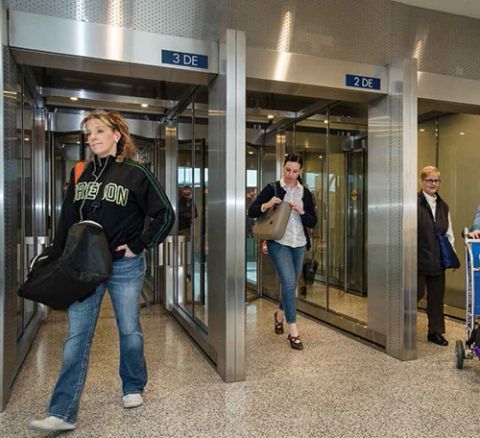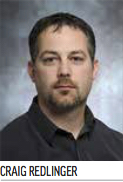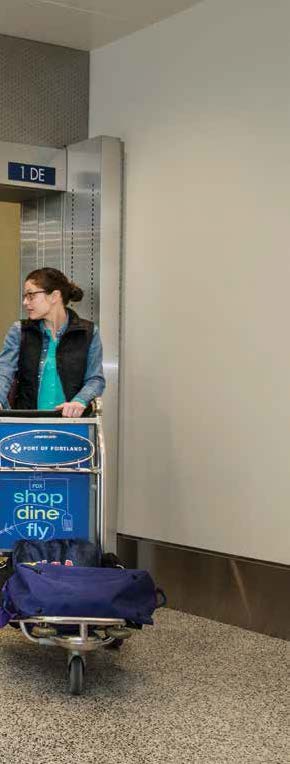Portland Int'l Installs Automated Exit Lane Breach Control System

Creating a security system is a lot like constructing a new building-it needs to be built properly to be strong, stable and function as intended.
In the last issue of Airport Improvement, we covered various foundational elements of the recent $53 million security system upgrade at Portland International Airport (PDX): a new identity management system and card readers, perimeter security upgrades, additional cameras, etc.
This issue, we examine the relocation and automation of PDX's exit lanes-the roof that tops off the security system construction to protect the airport's workers and 20 million annual passengers.
 facts&figures facts&figuresProject: Exit Lane Breach Control System Location: Portland Int'l Airport Cost: $600,000 New Configuration: 3 lanes on north side of terminal; 3 lanes on south side Consultant: Aviation Security Consulting/K2 Security Consulting/Carleton Hart Architects Construction General Manager: Hoffman Construction Co. Exit Lane Technology: Kaba (now dormakaba) Project Scope: Relocating & automating exit lanes |
PDX recently installed a $600,000 exit lane breach control system designed to maximize the flow of travelers through the terminals while maintaining the highest safety standards. The new one-way exit corridors guide arriving passengers to the public side of the airport without the need for staffed security personnel and are equipped with "smart technology" such as doors that lock and alert police in an emergency, safety features to ensure passengers won't get stuck inside, and floor sensors for dropped items.
PDX isn't the first U.S. airport to automate its exit lane security; that distinction belongs to McCarran International Airport. It is, however, evolving the unstaffed approach with new technology from Kaba (now dormakaba). "The version we have is the only U.S. installation of this technology, which uses sensors that can detect both direct and counter flow," says Dan Slauson, aviation security operations manager at the Port of Portland, which oversees operational systems of the joint civil-military airport. "Other airports have selected this same technology but haven't finished installing it yet."
Other exit lane systems primarily rely on mechanical systems such as revolving doors, corridors with sliding doors or one-way escalators with boundary doors at the top or bottom, he notes. "Most of these systems maintained a human staffing component to ensure that a breach does not occur, and unscreened or unbadged individuals do not have access to the sterile areas or aircraft," he explains.
Although the exit lane project was undertaken to further enhance security, it was not originally part of PDX's larger security upgrade. "We decided since we were starting an information technology-centric security project anyway, and positioning ourselves for future development within the terminal, we would add exit lane technology as well because we were already leveraging resources and employing a design team around security," explains Scott Shepler, information technology manager for security and access systems at the Port of Portland.
In addition, when the project was being planned in 2011, it appeared that TSA was no longer going to staff exit lanes, and airport operators would need to staff the lanes themselves. Although PDX's project was originally intended to get ahead of a TSA mandate that never materialized, the security team's research found that technology-driven systems are common in other parts of the world, they work as intended, and would fit well into the airport once its other work was complete.
 Higher-Tech Exits
Higher-Tech Exits
"Automated integrated exit lane technology is proven technology that offers flexibility for a relatively low cost," says Slauson. "The refinements of this technology make this a reliable solution for airports both large and small."
Kaba's Exit Lane Breach Control System includes a set of two glass doors and Plexiglas gates. The particular version at PDX was also built to the Port's exacting seismic requirements.
David Lenard, product manager of physical access system products for Kaba, describes how the system works: When a passenger approaches the exit lane from the sterile side, the doors open automatically. If someone tries to enter from the opposite direction (coming from the public side), sensors and a video analytic system within the unit will detect the attempt and close the doors. Sensors automatically communicate breaches to the airport's communications center. In addition, strategically positioned closed-circuit television cameras monitor the lanes and capture breaches on video.
 "Once the system goes into alarm, the airport gets an immediate notification automatically," says Lenard.
"Once the system goes into alarm, the airport gets an immediate notification automatically," says Lenard.
Because this is a new version of the Kaba system, project team members visited the designer/manufacturer in Germany to test it. "This took several months but resulted in the addition of stereo imagery video cameras," notes George Seamon, engineering project manager for the Port of Portland. "The old cameras would have potentially been fooled and impacted by shadows, but with stereo imaging cameras, it [operates] like your eyes. It has the capability of really seeing the passengers clearly. It can react much better and with less false alarms."
While safety and security were the project's top priorities, the team did not want the system to "cry wolf" and require unnecessary response from airport personnel. "We want to avoid any false alarms as best we could," Seamon remarks. "We worked with Kaba quite a bit to try and set the system up to maintain its secure monitoring of people while simultaneously weeding out any false alarms-because false alarms are still alarms. We react to them all the same."
 Some other systems sound false alarms for common issues, such as passengers swinging their arms backward while walking in the correct direction. "This was detected as a person walked backward," explains Craig Redlinger, construction manager at the Port of Portland.
Some other systems sound false alarms for common issues, such as passengers swinging their arms backward while walking in the correct direction. "This was detected as a person walked backward," explains Craig Redlinger, construction manager at the Port of Portland.
According to Kevin Richmond, president of K2 Security Consulting, a consultant who worked on the project, “the potential for false alarms was reduced greatly by “One of the key design decisions PDX made was to monitor all of the Kaba system outputs available with its access control system. This allowed the airport to provide the Kaba engineers with critical data as to the behavior of the systems during testing. This data coupled with archived video resulted in necessary software modifications to reduce nuisance and false alarms as well as achieving the airport’s desired functionality. Future airports installing these systems will also greatly benefit from the software “tweaks” made as these modifications will become part of Kaba’s standard offering.”
Changing Traffic Patterns
Before the recent changes, exit lanes at PDX were located side-by-side with entrances, near the security checkpoint-an arrangement that made the area very congested. While adding technology to the exit lanes, project designers also seized the opportunity to relocate the lanes to the north and south ends of the terminal.
Beyond easing congestion near the TSA checkpoints, the move also allowed crews to build the new lanes largely undisturbed. "We could close an area down to build the exit lanes," recalls Redlinger.
 Now, each of the airport's two exit areas has three lanes that operate in parallel and independently from one another. If one lane encounters a problem or needs routine maintenance, crews can shut down that lane while the other two still operate.
Now, each of the airport's two exit areas has three lanes that operate in parallel and independently from one another. If one lane encounters a problem or needs routine maintenance, crews can shut down that lane while the other two still operate.
The new lanes opened early this year, after testing in December 2016. The new exit lanes maximize the flow of travelers through the terminal by reducing congestion and also maintain the highest of safety standards, summarizes Redlinger.
"Passengers can still exit as quickly as they always have," reports Lenard. "And, with three lanes, if someone tries to come in from the non-secure side, it will shut the unit down. But the other two lanes are still open so people can continue to exit the terminal. They don't have to worry about people queuing up to exit the terminal."
 Because the new system included a major shift in passenger circulation, the project included a study of traffic flows within the airport. It also required other changes. For instance, PDX had to reverse the direction of several escalators between the ticket lobby, baggage claim area and tunnels on the north side to accommodate changes in passenger flow created by relocating the exit lanes. This change helped ensure that the first escalator travelers reach when leaving the terminal takes them directly to Baggage Claim.
Because the new system included a major shift in passenger circulation, the project included a study of traffic flows within the airport. It also required other changes. For instance, PDX had to reverse the direction of several escalators between the ticket lobby, baggage claim area and tunnels on the north side to accommodate changes in passenger flow created by relocating the exit lanes. This change helped ensure that the first escalator travelers reach when leaving the terminal takes them directly to Baggage Claim.
Beyond supplementing recent security enhancements, the new automated exit lanes are also the first step in the airport's terminal core refurbishment program. Part of that project will include new concessions to complement the new traffic patterns. Starbucks will be added in the A, B and C concourses; Portland Roasting Coffee will be located in the D and E concourses.
Because changes to long-standing layouts can confuse passengers who are accustomed to navigating a certain way, wayfinding signage was a critical part of the project. "Our exit lanes are not drastically changed in location, but they spit you out into the ticket lobby rather than through a breezeway that leads directly to Baggage Claim," says Slauson. "They put you just over 100 yards away from where the normal traffic flow was."
To minimize confusion, the airport employed temporary staff to assist customers. Extra personnel were placed in strategic locations to help direct passengers and meeters/greeters.
Although changing traffic patterns inside the terminal required additional signage and human assistance, Seamon notes that the overall change to automated exit lanes has been a positive one. Since the system has been in place, PDX has had only one passenger try to walk the wrong direction. "The system operated exactly as it should have," he reports. "It shut the lane down and stopped them from getting in."
What We Learned
Dan Slauson, aviation security operations manager for the Port of Portland, offers his insight on automated exit lane technology after helping implement it at Portland International Airport (PDX).
The two most obvious questions to ask when considering this technology are: Will the airport remain safe? and What is the return on investment?
The answer to the first question is yes, automated, integrated exit lane technology will maintain security as effectively as lanes staffed by humans. Actually, it provides breach alerts faster and to a larger audience.
At the most basic level, the return on investment is simply the difference between what it costs to staff current exit lanes and what it costs to procure, purchase and install the automated equipment. But this is a gross simplification. Other cost/benefit factors to consider include:
• Does your facility have a suitable location for automated exit lane corridors?
• Do you have the staffing, budget and time to take on the project?
• Do you have the necessary in-house expertise, or will you rely on contractors, integrators and consultants?
• Do the aesthetics of the equipment fit the style of your facility?
At PDX, there wasn't much discussion about whether we were going to do this project. The timing was strategic, since we were taking on a new identity management system, replacing access control systems and refurbishing our Emergency Communications Center. All of these projects required us to mobilize internally, hire a team of design and security consultants, and bring on contractors to perform the work.
It is critical to consider the bandwidth of individuals that will be involved. These projects put pressure on staff, especially when added to their regular workload. Our experience regarding teamwork during the installation of automated exit lanes and other security projects was fantastic. We found that a mature and talented project manager can set the tone from the beginning and that it's important to consider team make-up, experience, energy and attention to details. Melding a team together early on and creating an environment that allows it to accomplish initial milestones pays dividends throughout the project.
 Another important factor is project team growth and personal, professional development. Any successful team has accomplishments that are greater than the sum of the individual parts. This synergy must be nurtured and developed by the project manager, sponsor and team leaders. It is not enough to take advantage of opportunities that come along naturally; you must create situations that amplify team success.
Another important factor is project team growth and personal, professional development. Any successful team has accomplishments that are greater than the sum of the individual parts. This synergy must be nurtured and developed by the project manager, sponsor and team leaders. It is not enough to take advantage of opportunities that come along naturally; you must create situations that amplify team success.
Our project team included the usual broad cross-section of disciplines: general and subcontractors, manufacturers, design consultants, airport construction management, construction inspectors, airport engineering and airport security. Some of the less obvious partners included our Operations and Maintenance Departments, communications center, airport police, airport rescue and firefighting and TSA. The project team was responsible for leveraging relationships around the entire airport environment to provide communication about the project, to receive feedback about the logistical impacts of the project and to anticipate operational impacts.
Before the delivery and installation of the new exit lane equipment, the team worked diligently to understand all of its components. It was important to know how they function, how the equipment integrates hardware with analytics to create events and alarms, and how their outputs would be used. The advanced analytics generate more than one type of alarm for breach scenarios. Understanding these complexities helps determine how the technology should be configured, what it will report, whom it will report to and who will react to various events.
A detailed plan to conduct factory acceptance testing of the equipment is imperative. It is not practical to conduct this testing outside the factory, so travel will be required. The two main benefits of this process are technical sign-off of each specification prior to taking delivery and access to manufacturing staff, engineers, programmers and technicians. Taking delivery of equipment that did not work properly prior to shipment is both expensive and time-consuming. The relationships and information gained by spending time with manufacturer staff on their turf is priceless. Learning about subtleties and nuances of the equipment is worth the time. It's also valuable to understand how the equipment functions from the perspective of those who developed it.
Being present for all stages of installation is another critical step. Again, there are benefits in listening to the factory installers talk about the equipment from their perspective. This serves as a bridge between theoretical information in manuals and cut sheets to how the equipment functions from an everyday practical standpoint.
Local testing should be divided into two distinct categories: Does the equipment function properly from a technical standpoint? and Does the equipment detect what it is supposed to and does it report correctly?
The technical testing requires tireless attention to detail, but is a critical first step. Isolating technical deficiencies will assist in the functional testing later. Knowing that the components were manufactured, assembled and installed correctly will eliminate the hardware components from consideration if there are functional failures later.
During functional testing, it is vital to have a meticulous plan. The more detailed and methodical your initial road map is, the better the recorded documentation will be. And detail will be invaluable when working on certification later. These details are also important if/when changes are made to hardware, firmware or software or any combination of the three. We experienced many iterations of software or programming as we discovered issues with the function of the equipment. Upgrades and changes were made, and testing began again. The new testing was methodical to ensure that new problems were not introduced, and fixes were achieved. This is tedious and repetitive, but critical to the overall process.
Functional testing should involve assessments for intentional acts of sabotage or breach, and also for accidental or random events. We realized that much of our security thinking is focused on purposeful acts designed to harm or disrupt the facility. Although this is sound, practical thinking to protect people and critical infrastructure, it does not account for accidental, random occurrences. We added a new layer of thinking to include everyday events such as lost, disoriented or unseasoned travelers. Our experiences suggest that accounting for both types of events cover almost every scenario that will be encountered. Uncovering a gap in one area usually provided a solution for other areas.
2022 Charlotte Douglas International Airport Report of Achievement
 Giving back to the community is central to what Charlotte Douglas International Airport and its operator, the City of Charlotte Aviation Department, is about, and last year was no different.
Giving back to the community is central to what Charlotte Douglas International Airport and its operator, the City of Charlotte Aviation Department, is about, and last year was no different.
Throughout 2022, while recovering from the COVID-19 pandemic, we continued our efforts to have a positive impact on the Charlotte community. Of particular note, we spent the year sharing stories of how Connections Don't Just Happen at the Terminal - from creating homeownership and employment opportunities to supporting economic growth through small-business development and offering outreach programs to help residents understand the Airport better.
This whitepaper highlights the construction projects, initiatives, programs and events that validate Charlotte Douglas as a premier airport.
Download the whitepaper: 2022 Charlotte Douglas International Airport Report of Achievement.








